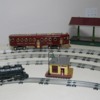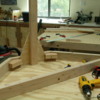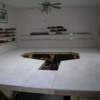Replies sorted oldest to newest
Here's mine. I have a very similar space to work with (13x13). It essentially consists of a loop of STD-87 track around an 0 gauge layout. The four outer corners will be used for Standard Gauge buildings and accessories. The Standard Gauge track is from USA Track. Construction is modular but a bit unconventional; I can post some photos of the construction techniques involved if you are interested. All lumber was squared up with a jointer and planer, and table tops were trimmed with a router so they would mate up without gaps. Access is through a removable section; the joint lines can be seen in the foreground of the first two photos. I generally just use it as a duck-under, removing the section only if I'm going to going back and forth a lot working on the layout or if a friend with a physical handicap visits.
Here are the photos. The first three show the basic configuration. The last photo, taken quite a bit after the first three, shows the 0 gauge yard and control panel.
Attachments
Next, I figured out a configuration for the modules. I made a couple of minor changes as I was building it to adapt to available sizes of plywood, but this was basically how it was built.
Here's how one of the corner modules was built. Note the bracing on the obtuse-angle joints, and the hole in the middle of the cross-brace for wiring. The small router sitting on top of the module is the one I used to trim the table top. It uses an oversize base plate and a flush-cutting bit with a roller guide.
Here is the first group of modules in place, followed by a shot of the entire layout in white primer before I started to lay track.
And that's the construction phase.
Attachments
I have built a couple of portable layouts that incorporated a loop of 5 rail. It has proven very reliable. As of Halloween, my garage layout is in process of being redone with two 5 rail loops. Hopefully it will be at least operational before the end of the year.
Steve
Southwest, awesome pictures, thank you! I dont have but hand tools but i think I can do some of that!
You all rock!! Thanks for the replies
Southwest Hiawatha posted:Here's mine. I have a very similar space to work with (13x13). It essentially consists of a loop of STD-87 track around an 0 gauge layout. The four outer corners will be used for Standard Gauge buildings and accessories. The Standard Gauge track is from USA Track. Construction is modular but a bit unconventional; I can post some photos of the construction techniques involved if you are interested. All lumber was squared up with a jointer and planer, and table tops were trimmed with a router so they would mate up without gaps. Access is through a removable section; the joint lines can be seen in the foreground of the first two photos. I generally just use it as a duck-under, removing the section only if I'm going to going back and forth a lot working on the layout or if a friend with a physical handicap visits.
Here are the photos. The first three show the basic configuration. The last photo, taken quite a bit after the first three, shows the 0 gauge yard and control panel.
WHAT is that Virginia and Truckee piece?? How fun, it makes me think of the Nautilus in "20,000 Leagues under the Sea" with James Mason!
Just a word to the wise from someone who's been there. 5 rail track is a great idea if someone made curves for 5 rail. I had Gargraves 5 rail and it was the biggest "PITA" to work with then you can emagine. I had a 72" loop and all the curves have to be bent as best you can and cut to fit bla,bla,bla! The track never fit together right and the curves were not true. I like to think I have a bit of mechanical ability but that stuff was not worth the time,money and hassle! If I had the space and time I would make 5 rail from good old tried and true tubular track like Steve and Scott did. Just last week I got some curves of standard gauge 72" from Kirk at USA track and the quality of their track is second to none!
Here is a video of my layout the LCCA did a while back just to give you an idea of how my layout is set up.






























